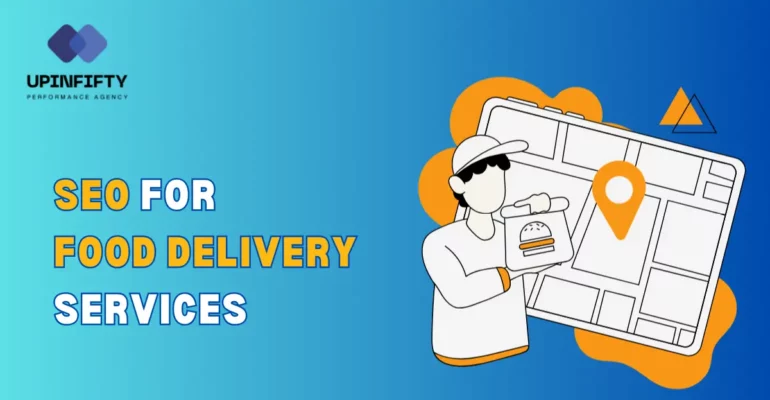How Can SEO Help Your Food Delivery Services Grow Quickly?

How Can SEO Help Your Food Delivery Services Grow Quickly?
Table of Contents
This article will look at the cost of SEO for food delivery services, providing a critical analysis and practical advice to help your online business succeed. In today’s digital world, the food delivery sector is expanding quickly, with many companies competing for the attention of hungry people. Food delivery services need to use search engine optimization, or SEO, to set themselves alone in this highly competitive field.
Understanding SEO for Food Delivery Services
What is SEO?
The process of making your website more visible on search engines like Google, Bing, and Yahoo is known as search engine optimization, sometimes known as seek engine marketing and advertising. By improving different parts of your website online, you can also rank higher in search results, receive more natural visits, and draw in new clients for your business.
Why is SEO Important for Food Delivery Services?
There are various reasons why SEO for food delivery service matters for food delivery services:
Increased Visibility: Better search engine results increase your company’s visibility and attract additional possible customers.
Cost-Effective Marketing: When compared to traditional marketing strategies, search engine optimization (SEO) is a more affordable yet effective way to reach your audience.
Enhanced User Experience: Optimizing your website results in an enhanced user experience that increases customer satisfaction and loyalty.
Competitive Edge: Gaining an advantage over competitors in search results ensures that you will take a larger portion of the market.

Key SEO Strategies for Food Delivery Services
1. Conducting Keyword Research
Identifying Relevant Keywords
The basis of any successful SEO for food delivery service campaign is keyword research. Look for terms and keywords that people might use to locate food delivery businesses. You can find high-extent, low-opposition keyword phrases with the use of tools like Ahrefs, Google Keyword Planner, and SEMrush.
Long-Tail Keywords
Compared to big key phrases, long-tail keywords are frequently far less competitive and more accurate. For example, rather than focusing on “meals delivery,” you may consider “organic meals delivery in Texas.”Long-tail keyword phrases can drive highly targeted traffic to your website.
2. On-Page SEO Optimization
Title Tags & Meta Tags
Meta tags and titles are essential for SEO. Make sure your website not only has unique meta tags for each page, but also a name tag that is packed with keywords and a catchy meta description that encourages visitors to click.
Header Tags (H1 to H6)
Make sure your header tags (H1 to H6) are correct. This will help search engines like Google understand the organization and content of your page. Your H1 tag should include your major keyword, while your H2 and H3 tags should contain secondary keywords.
Quality Content
Search engine marketing, content is the absolute king. Make sure you provide top-notch, captivating content that benefits your intended audience. If you would want to share recipes, food transportation tips, and industry news, think about putting a weblog section on your website.
3. Local SEO
My Business on Google (GMB)
It is essential for local search engine marketing to claim and improve your Google My Business (GMB) presence. Check that your GMB profile has all the necessary information, including your company number and any additional relevant information like your website’s URL address, phone number, and operating hours.
Local keywords
Incorporate meta tags and nearby keywords into your article. Use expressions such as “nice food shipping in [your city]” to draw in local clients.
4. Mobile Optimization
Mobile-Friendly Design
With so many people visiting websites on mobile devices, it is necessary to have a mobile-friendly layout. Make sure your website is responsive, which enables it to easily adjust to a wide range of screen sizes.
Page Speed
Page speed is an important factor in rating. You may speed up the loading of pages on laptops and mobile devices by optimizing images, using browser caching, and lowering JavaScript.
5. Link Building
Building internal hyperlinks helps search engines in understanding the organization of your website and creates a structure of relevance for your content, which makes link building an important aspect of search engine marketing. Thus, be sure to connect to relevant pages on your website to improve search engine optimization and user experience.
However, acquiring high-quality backlinks from trustworthy websites will strengthen your search engine marketing campaigns. Make contact with local organizations, business leaders, and food bloggers to establish relations and obtain useful one-way linkages.
6. User Experience and Engagement
A well-designed and easy-to-use website significantly enhances user experience and motivates users to stay on it longer. Users may quickly locate the facts they need with the help of simple choices and an efficient seek function, which raises user happiness and basic engagement. Good customer reviews are also crucial for building trust with potential consumers and improving local search engine marketing, therefore it’s critical to encourage satisfied customers to post reviews on your Google My Business profile and other review platforms.
Measuring and Analyzing SEO for Food Delivery Service Performance
Using Analytics Tools
To improve the overall success of your search engine marketing, make use of tools like Google Analytics and Google Search Console. Track performance indicators such as organic traffic, bounce rate, and conversion cost to evaluate how well your SEO working for food delivery service.
Regular Audits
Conduct routine SEO for food delivery service audits to find areas that require improvement. Examine your material for errors, duplicate content, and other problems that can be hurting your ratings.
Staying Updated
The field of search engine optimization is always changing. To make sure your tactics continue to be effective, stay up to current on the latest trends and regulatory changes. To stay ahead of the curve, participate in corporate forums, seminars, and search engine optimization blog subscriptions.
Conclusion
For your SEO food delivery service business to remain competitive in the online market and attract in new clients, search engine optimization is essential. You can dramatically improve your search engine rankings and drive more traffic to your website by doing complete keyword research, applying on-page and local SEO strategies, optimizing for mobile, building quality oneway links, and improving user experience.
Keep in mind that search engine optimization is an ongoing process that needs constant attention to detail. Maintaining a commitment to quality procedures and regularly evaluating your operations can help your food delivery company expand and succeed over the long run.
Remember working with a reputable search engine marketing company that specializes in shipping services if you want expert assistance in improving your food delivery service for search engine marketing. Their experience and specially designed methods help you achieve your business goals by guiding you through the complicated world of search engine marketing.





